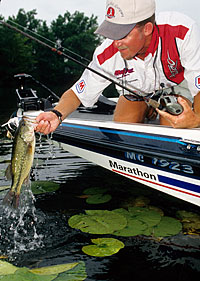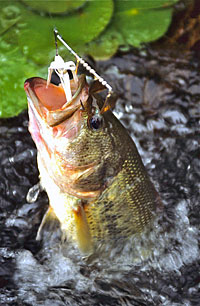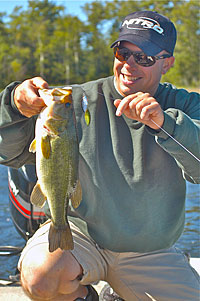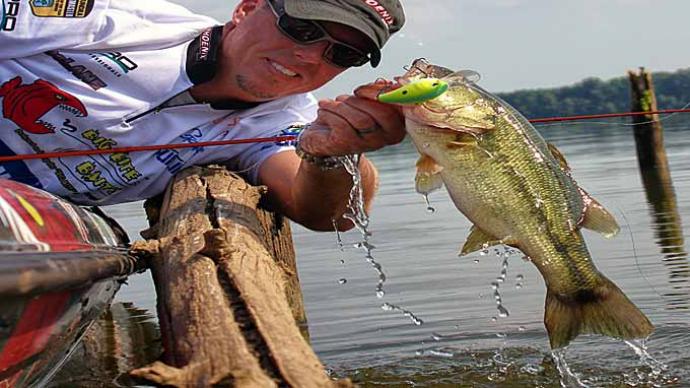
Largemouth bass have been custom-built by the Creator to fill a specific niche. Their survival hinges on securing prey whose intake and positive energy production allow a bass to grow and eventually procreate. Largemouth bass have adapted to take advantage of various food sources in their environments. Bass are adept at chasing down prey if need be. Bass can target schools of pelagic baitfish in open water far removed from any cover. They can also patrol ledges and weed lines in marauding schools to trap and herd unsuspecting pods of panfish and baitfish.
However, largemouth bass are most adept at ambushing. Ambushing produces the most effective return on energy expenditure and protein intake. Sitting still and waiting for food to come to you has its advantages.
Largemouth bass, in particular, feel most at home in warm, highly vegetated waters where their metabolism and motivation is peak, and they can lie in wait for dinner. Weeds provide ideal ambush cover. Vegetation or weeds take various forms depending on the climate. Largemouths quickly adapt to whatever kind of weeds prevail, whether vertical or horizontal. Edges are important. Holes perpetuated by gravel, rocks, boulders, or a hard bottom are places you’ll find bass concentrated in a seemingly endless raft of weeds.

While bass will use even an expansive, monotonous weed bed, places where plant species intermingle and compete are especially attractive. This might be due to water depth or bottom composition, but edges, where two or three plant varieties meet can be perfect. Add some milfoil to a canopy of lily pads with some flooded timber, a stump, or lay down nearby, and you have the makings of a bass Nirvana.
Weed lines that feature indentations, cups, points, and isolated clumps are best for marauding predators like bass. Hunting as a group, they can pin baitfish against the weeds and pick off panicked, disoriented fish. Or they can stalk alone, setting up ambush points afforded by these irregular weed lines.
Some weed types are found across the country. Wherever they’re found, they can be counted on to hold bass: water lilies, coontail, dollar bonnets, Eurasian milfoil, Potamogeton, cabbage, and others. The specie is not important. The fact that they provide cover and food for bass is extremely important.
Vegetation comes in two primary forms - floating and submerged. Floating vegetation provides overhead cover that protects bass from the sun and heat in the summer and provides a vantage point from which bass can strike unsuspecting prey. Floating vegetation can form dense mats of water hyacinths not anchored to the bottom and drift according to the wind. Surface plants, like water lilies, American lotus, and others, are less dense, with plenty of openings where bass can hunt and stalk.
Submerged plants provide cover for bass at different levels. These plants grow toward the water surface and sunlight. How tall the plants grow depends on water clarity and light penetration. In ultra-clear water, it’s not uncommon for coontail, cabbage, and Potamogeton to reach 20 feet or more. This provides bass with many places and levels at which to hunt. You can find bass at the surface, mid-depths, or on the bottom. Determining their preferred level will influence your approach, presentations, and productive baits.

Bass will hold just under the surface and floating weeds, particularly in the summer, to stay cool and, in the winter, to soak up the sunshine. Many times this might only be in 3 or 4 feet of water. Bass can be super spooky depending on the density of the weeds and the depth. Anglers need to use a very stealthy approach in more open floating vegetation. Bass holding just under the surface are on high alert, and powering in close to an area or even a whirling trolling motor can send them scurrying. Use the wind whenever possible, quietly drift into position, and utilize your shallow-water anchors to hold a position, especially if the wind is blowing hard. Give the area a few minutes to calm down.
Bass positioned near the surface in floating vegetation have their bib on. They realize floating weeds present an array of food sources and take advantage of them. The buffet may include small fish, invertebrates, aquatic insects, and mammals. Floating vegetation is desirable to young of the year panfish, a favorite in a largemouth’s diet. Crayfish abound in the weeds, and frogs, toads, ducklings, moths, snakes, mice, and rats find themselves adrift and floundering in the vegetation. All become dinner for bass.
Weeds present a plethora of food sources. As a result, a variety of lures excel for probing the vegetation. Things like frogs and rats are highly productive and fun skipping across a thick mat of vegetation and watching the bass explode from below. Because these types of baits are weedless, you can fish them anywhere. Buzz baits are a hoot to fish and can trigger smashing strikes from shallow bass. Not many bass anglers look to spoons anymore, but one of my favorites for surface weeds and out-sized bucketmouths is a Johnny O’ Neil Weed Wing with a pork trailer.
In extremely thick mats of surface weeds, punching a heavy jig through the vegetation may be the only way to get at weed-loving bass. Use a jig rigged Texas-style with just enough weight to break through the mat and draw it up to the underside of the weeds. Jig it and hop it there and hold on.

Bass may suspend among the leaves anywhere in the water column in tall leafy vegetation. As the leaves become dense and flourish near the surface, bass will hold somewhere in between to take advantage of the protective canopy and utilize the more open space below to watch for prey.
Because bass holding in the middle depths can be found anywhere in the water column, they can be tough to target. A key to realizing that bass are up off the bottom is when you’re getting bites on the drop. You need to be highly observant to note a kink in your line, a slight tick, or sideways movement as a lure drops. If the vegetation is somewhat sparse, maneuvering a slow-rolled spinnerbait through the jungle can pay big dividends on bass holding at mid-depth. Topwater baits like the classic Pop-R can induce explosive strikes if there are pockets in the weeds. You can also pitch plastics into the holes and let them flutter down to waiting bass.
Bass are conditioned to cruise near the bottom where floating mats are particularly thick, or submerged vegetation is incredibly dense. Punching a heavy jig is about the only way to reach these fish. It’s a plant– your–feet, rare back and set the hook, heavy-duty scenario. Don’t spare the rod or the line. This is a place for a 7 ½- to 8-foot stout rod with at least 50-pound braid.
Bullet-head weights rigged Texas-style combined with an active skirt and plastic in the form of crawdads, lizards and creatures are a perfect tool for busting through heavy mats. 3/8- to ½-ounce weights are perfect for most situations, but you may have to upgrade to as much as 2 ounces for the really nasty stuff. Tungsten weights are preferred because of their smaller size and density, but if you’re fishing the northern climes in North America, where toothy northerns are common, one chomp could cost you your lunch money.
Punching a creature rig through the grass usually produces and reaction bite. The rig hitting bottom gets toe tentacles and legs to quiver, and bass may immediately hit the lure. If not, add a little hop or shake to convince bass that have seen the bait but aren’t convinced.
Largemouth bass and weeds are like peanut butter and jelly. It is summertime, weeds, and largemouth bass – it is a match made in heaven.




